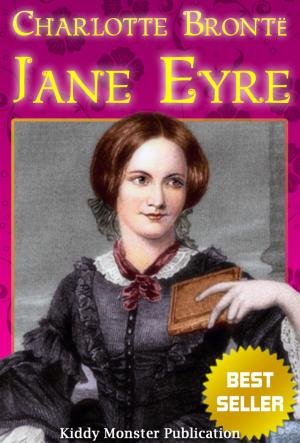The Tempest By William Shakespeare
With 30+ Original Illustrations,Summary and Free Audio Book Link
Fiction & Literature, Literary Theory & Criticism, British, Nonfiction, Entertainment, Drama, Shakespeare| Author: | William Shakespeare | ISBN: | 9789879990469 |
| Publisher: | Kiddy Monster Publication | Publication: | February 11, 2013 |
| Imprint: | Language: | English |
| Author: | William Shakespeare |
| ISBN: | 9789879990469 |
| Publisher: | Kiddy Monster Publication |
| Publication: | February 11, 2013 |
| Imprint: | |
| Language: | English |
The Tempest By William Shakespeare - With 30+ Original Illustrations,Summary and Free Audio Book Link
FEATURES:
• Title contains every original Illustrations from Danziel Brothers.
• Title contains Summary
• FREE audio book link at the end of the book
• William Shakespeare's Biography
• William Shakespeare's Top Quotes
• Easy to navigated Active Table of Contents
• High formatting quality and standards, manually crafted by professionals
The Tempest is a play by William Shakespeare, believed to have been written in 1610–11, and thought by many critics to be the last play that Shakespeare wrote alone. It is set on a remote island, where Prospero, the rightful Duke of Milan, plots to restore his daughter Miranda to her rightful place using illusion and skillful manipulation. He conjures up a storm, the eponymous tempest, to lure his usurping brother Antonio and the complicit King Alonso of Naples to the island. There, his machinations bring about the revelation of Antonio's lowly nature, the redemption of the King, and the marriage of Miranda to Alonso's son, Ferdinand.
There is no obvious single source for the plot of The Tempest, but researchers have seen parallels in Erasmus's Naufragium, Peter Martyr's De orbe novo, and an eyewitness report by William Strachey of the real-life shipwreck of the Sea Venture on the islands of Bermuda. In addition, one of Gonzalo's speeches is derived from Montaigne's essay Of the Canibales, and much of Prospero's renunciative speech is taken word for word from a speech by Medea in Ovid's poem Metamorphoses. The masque in Act 4 may have been a later addition, possibly in honour of the wedding of Princess Elizabeth and Frederick V in 1613. The play was first published in the First Folio of 1623.
The story draws heavily on the tradition of the romance, and it was influenced by tragicomedy and the courtly masque and perhaps by the commedia dell'arte. It differs from Shakespeare's other plays in its observation of a stricter, more organised neoclassical style. Critics see The Tempest as explicitly concerned with its own nature as a play, frequently drawing links between Prospero's "art" and theatrical illusion, and early critics saw Prospero as a representation of Shakespeare, and his renunciation of magic as signalling Shakespeare's farewell to the stage. The play portrays Prospero as a rational, and not an occultist, magician by providing a contrast to him in Sycorax: her magic is frequently described as destructive and terrible, where Prospero's is said to be wondrous and beautiful. Beginning in about 1950, with the publication of Psychology of Colonization by Octave Mannoni, The Tempest was viewed more and more through the lens of postcolonial theory—exemplified in adaptations like Aim? C?saire's Une Temp?te set in Haiti—and there is even a scholarly journal on post-colonial criticism named after Caliban. Because of the small role that women play in the story, The Tempest has not attracted much feminist criticism. Miranda is typically viewed as having completely internalised the patriarchal order of things, thinking of herself as subordinate to her father.
The Tempest did not attract a significant amount of attention before the closing of the theatres in 1642, and only attained popularity after the Restoration, and then only in adapted versions. In the mid-19th century, theatre productions began to reinstate the original Shakespearean text, and in the 20th century, critics and scholars undertook a significant re-appraisal of the play's value, to the extent that it is now considered to be one of Shakespeare's greatest works. It has been adapted numerous times in a variety of styles and formats: in music, at least 46 operas by composers such as Fromental Hal?vy, Zden?k Fibich and Thomas Ad?s; orchestral works by Tchaikovsky, Arthur Sullivan and Arthur Honegger; and songs by such diverse artists as Ralph Vaughan Williams, Michael Nyman and Pete Seeger; in literature, Percy Bysshe Shelley's poem With a Guitar, To Jane and W. H. Auden's The Sea and the Mirror; novels by Aim? C?saire and The Diviners by Margaret Laurence; in paintings by William Hogarth, Henry Fuseli, and John Everett Millais; and on screen, ranging through a hand-tinted version of Herbert Beerbohm Tree's 1905 stage performance, the science fiction film Forbidden Planet in 1956, to Peter Greenaway's 1991 Prospero's Books featuring John Gielgud as Prospero.
The Tempest By William Shakespeare - With 30+ Original Illustrations,Summary and Free Audio Book Link
FEATURES:
• Title contains every original Illustrations from Danziel Brothers.
• Title contains Summary
• FREE audio book link at the end of the book
• William Shakespeare's Biography
• William Shakespeare's Top Quotes
• Easy to navigated Active Table of Contents
• High formatting quality and standards, manually crafted by professionals
The Tempest is a play by William Shakespeare, believed to have been written in 1610–11, and thought by many critics to be the last play that Shakespeare wrote alone. It is set on a remote island, where Prospero, the rightful Duke of Milan, plots to restore his daughter Miranda to her rightful place using illusion and skillful manipulation. He conjures up a storm, the eponymous tempest, to lure his usurping brother Antonio and the complicit King Alonso of Naples to the island. There, his machinations bring about the revelation of Antonio's lowly nature, the redemption of the King, and the marriage of Miranda to Alonso's son, Ferdinand.
There is no obvious single source for the plot of The Tempest, but researchers have seen parallels in Erasmus's Naufragium, Peter Martyr's De orbe novo, and an eyewitness report by William Strachey of the real-life shipwreck of the Sea Venture on the islands of Bermuda. In addition, one of Gonzalo's speeches is derived from Montaigne's essay Of the Canibales, and much of Prospero's renunciative speech is taken word for word from a speech by Medea in Ovid's poem Metamorphoses. The masque in Act 4 may have been a later addition, possibly in honour of the wedding of Princess Elizabeth and Frederick V in 1613. The play was first published in the First Folio of 1623.
The story draws heavily on the tradition of the romance, and it was influenced by tragicomedy and the courtly masque and perhaps by the commedia dell'arte. It differs from Shakespeare's other plays in its observation of a stricter, more organised neoclassical style. Critics see The Tempest as explicitly concerned with its own nature as a play, frequently drawing links between Prospero's "art" and theatrical illusion, and early critics saw Prospero as a representation of Shakespeare, and his renunciation of magic as signalling Shakespeare's farewell to the stage. The play portrays Prospero as a rational, and not an occultist, magician by providing a contrast to him in Sycorax: her magic is frequently described as destructive and terrible, where Prospero's is said to be wondrous and beautiful. Beginning in about 1950, with the publication of Psychology of Colonization by Octave Mannoni, The Tempest was viewed more and more through the lens of postcolonial theory—exemplified in adaptations like Aim? C?saire's Une Temp?te set in Haiti—and there is even a scholarly journal on post-colonial criticism named after Caliban. Because of the small role that women play in the story, The Tempest has not attracted much feminist criticism. Miranda is typically viewed as having completely internalised the patriarchal order of things, thinking of herself as subordinate to her father.
The Tempest did not attract a significant amount of attention before the closing of the theatres in 1642, and only attained popularity after the Restoration, and then only in adapted versions. In the mid-19th century, theatre productions began to reinstate the original Shakespearean text, and in the 20th century, critics and scholars undertook a significant re-appraisal of the play's value, to the extent that it is now considered to be one of Shakespeare's greatest works. It has been adapted numerous times in a variety of styles and formats: in music, at least 46 operas by composers such as Fromental Hal?vy, Zden?k Fibich and Thomas Ad?s; orchestral works by Tchaikovsky, Arthur Sullivan and Arthur Honegger; and songs by such diverse artists as Ralph Vaughan Williams, Michael Nyman and Pete Seeger; in literature, Percy Bysshe Shelley's poem With a Guitar, To Jane and W. H. Auden's The Sea and the Mirror; novels by Aim? C?saire and The Diviners by Margaret Laurence; in paintings by William Hogarth, Henry Fuseli, and John Everett Millais; and on screen, ranging through a hand-tinted version of Herbert Beerbohm Tree's 1905 stage performance, the science fiction film Forbidden Planet in 1956, to Peter Greenaway's 1991 Prospero's Books featuring John Gielgud as Prospero.















